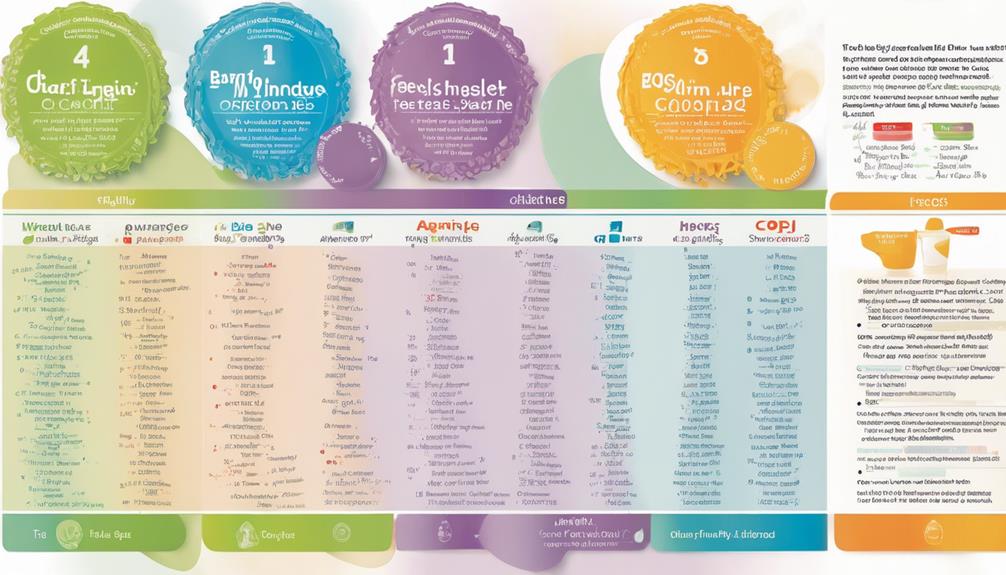Some people may have concerns about the safety of taking AZO while breastfeeding, but it is important to carefully consider how it could affect the nursing baby. Understanding the potential benefits and risks is crucial before making any decisions to protect the well-being of both the mother and her child.
With concerns surrounding Hemolytic Anemia, Methemoglobinemia, and Sulfhemoglobinemia, managing the use of AZO during breastfeeding requires careful consideration. Stay tuned to learn more about the specific guidelines and recommendations for using AZO while nursing.
Key Takeaways
- Avoid AZO while breastfeeding to prevent harmful components in breast milk.
- Consult a healthcare provider before considering AZO use during breastfeeding.
- Risks of hemolytic anemia, methemoglobinemia, and sulfhemoglobinemia are associated with AZO.
- Protect infant health by refraining from AZO and seeking professional advice.
Safety of AZO While Breastfeeding
When considering the safety of taking AZO while breastfeeding, it's important to acknowledge the potential risks posed to the infant.
AZO, containing Phenazopyridine Hydrochloride as its active ingredient, can transfer into breast milk, potentially causing orange discoloration and severe side effects in infants. These adverse effects are especially concerning for babies under 4 weeks old, highlighting the importance of avoiding AZO while breastfeeding.
Severe complications such as methemoglobinemia, sulfhemoglobinemia, and hemolytic anemia have been associated with the ingestion of AZO during breastfeeding, underscoring the need for caution. Despite limited research on the exact extent of AZO components passing into breast milk, erring on the side of safety is paramount.
It's advisable to refrain from using AZO while breastfeeding to protect the health and well-being of the infant. Remember, the potential risks far outweigh any perceived benefits in this scenario.
Potential Risks and Benefits

To fully understand the implications of taking AZO while breastfeeding, it is important to weigh the potential risks and benefits associated with this decision. While AZO may provide relief from urinary pain, it contains Phenazopyridine Hydrochloride, which can pass into breast milk and potentially harm the infant. Here is a breakdown of the potential risks and benefits:
| Potential Risks | Potential Benefits |
|---|---|
| – Transfer of harmful components into breast milk | – Relief from urinary pain |
| – Methemoglobinemia, sulfhemoglobinemia, hemolytic anemia risks | – Improved quality of life for the mother |
| – Limited research on effects on infants | – Enhanced comfort and well-being |
| – Caution advised in usage, especially for infants under one month old or those with G6PD deficiency | – Convenience of symptom management |
Considering these factors, it is pivotal to consult a healthcare provider before using AZO while breastfeeding to make an informed decision prioritizing the well-being of both the mother and the infant.
Hemolytic Anemia Concern
Amidst concerns surrounding hemolytic anemia, the potential risks of taking AZO while breastfeeding are underscored by the risk of red blood cell destruction and consequent anemia. When considering the implications of hemolytic anemia in the context of breastfeeding, it's important to prioritize the well-being of both the mother and the infant. Here are some essential points to keep in mind:
- Hemolytic Anemia Risk: AZO usage during breastfeeding can elevate the risk of hemolytic anemia due to its impact on red blood cells.
- Potential Complications: Hemolytic anemia can lead to severe health complications, emphasizing the significance of avoiding AZO in breastfeeding mothers.
- Consult Healthcare Providers: Seeking guidance from healthcare professionals before using AZO while breastfeeding is important to mitigate the risk of hemolytic anemia.
- Informed Decisions: Understanding the connection between AZO, hemolytic anemia, and breastfeeding can empower mothers to make informed decisions regarding medication safety.
Methemoglobinemia Risk

The risk of methemoglobinemia is a significant concern associated with phenazopyridine, the active ingredient found in AZO products. Phenazopyridine has the potential to increase the production of methemoglobin, a form of hemoglobin that can't efficiently release oxygen to tissues, impacting its oxygen-carrying capacity. Elevated levels of methemoglobin can lead to tissue hypoxia, depriving cells of oxygen, and result in functional anemia. This condition poses a threat to the normal oxygenation of the body, which is critical for overall health, particularly while breastfeeding.
Understanding the potential risk of methemoglobinemia is important when considering the use of AZO products during this period. It's important to consult with a healthcare provider before using any medication containing phenazopyridine while breastfeeding, as they can provide guidance on the safest options to manage symptoms without compromising maternal or infant health.
Sulfhemoglobinemia Considerations
Considering the potential risks of methemoglobinemia associated with phenazopyridine, it's important to also be aware of the implications of sulfhemoglobinemia when contemplating the use of AZO products while breastfeeding. Here are some key points to keep in mind:
- Sulfhemoglobinemia Basics: This condition hinders hemoglobin's ability to carry oxygen effectively.
- Phenazopyridine Connection: Sulfhemoglobinemia can arise as a side effect of phenazopyridine, the active compound in AZO products.
- Risk of Impaired Oxygen Delivery: Sulfhemoglobinemia can lead to reduced oxygen transport to tissues, potentially causing harm.
- Consult a Healthcare Provider: To prevent sulfhemoglobinemia in infants, it's essential to avoid phenazopyridine while breastfeeding. Seeking guidance from a healthcare provider for safe alternatives is highly recommended to mitigate the risks associated with sulfhemoglobinemia.
When it comes to sulfhemoglobinemia risks while breastfeeding, being proactive and informed is key to ensuring the health and well-being of both the mother and the child.
Frequently Asked Questions
What Can I Take for a UTI While Breastfeeding?
We can treat UTIs while breastfeeding with antibiotics like amoxicillin or cephalexin. Cranberry supplements may complement antibiotic therapy. It's important to follow the prescribed regimen to clear the infection and prevent recurrence. Consulting healthcare providers is essential for proper treatment.
Is It Safe to Take Azo D Mannose While Breastfeeding?
While the safety of Azo D Mannose during breastfeeding lacks specific data, its minimal absorption and quick excretion suggest low risk. Consult with a healthcare provider for personalized guidance, considering individual responses and health goals.
When Should You Not Take Azo?
We should not take AZO when experiencing severe side effects, allergic reactions, or if pregnant. It's important to heed warnings and consult healthcare providers if in doubt. Prioritizing safety is key for our well-being.
Is It Safe to Take Cranberry Pills While Breastfeeding?
Yes, it is safe to take cranberry pills while breastfeeding. They can help prevent UTIs by inhibiting bacteria from adhering to the urinary tract walls. Consulting a healthcare provider is recommended for safety.
Conclusion
To sum up, it's best to avoid taking AZO while breastfeeding to guarantee the safety of both the mother and the baby.
While some may argue that the benefits of AZO outweigh the risks, the potential for severe side effects and harm to the infant can't be ignored.
It's important to prioritize the well-being of your child and consult with a healthcare provider for safer alternatives to manage urinary pain while breastfeeding.










